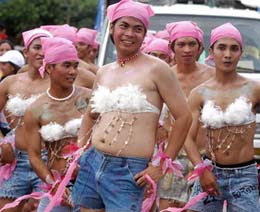
WHEN Pampanga was established as a province in 1571, it was about ten times its present size, and according to the 1903 Census of the Philippine Islands,“embraced all the central plain north from Bulacan to the missions of Cagayan and its mountains.”
Over the years, the Spaniardscarved out other provinces from it, in a process usually accompanied by the retreat of the Kapampangan language before an expanding Tagalog. Whereas there is evidence that most of Bulacan and Nueva Ecija, Eastern Bataan and Tondo were Kapampangan at the beginning of the Spanish conquest, the Kapampangan area is now confined to Pampanga, Southern Tarlac and rapidly retreating remnants in Bataan and Nueva Ecija, with the language shift going on at an even faster rate. Today, Kapampangans form a minority in Tagalog-dominated “Gitnang Luson,” and unless something is done, will be reduced to insignificance or disappear as an distinct people in a few decades.
It has not always been so. Kapampangans have often been described as “clannish,” a negative term used in Manila.
Their reputation in the metropolis as being mayabang included pride in their native culture and language, which they spoke with each other on every occasion, even outside their home region. This stubborn sense of identity and consciousness of their heritage allowed them to survive as a distinct people even as they were surrounded by their large, rapidly expanding neighbors, the Tagalogs and the Ilocanos.
Ironically it was the mt.pinatubo that brought a rebirth of faced with the prospect of annihilation as a people, we reaffirmed a culture long neglected.
One off shoot of this revival is an increasing acceptance of the concept of a kapampangan region beyond the boundaries of the province.
Kapampangan was also known by their uniqueness,because of their tradition and culture one of this was the “Lubenas”.
It is a procession on land (limbun, to differentiate it from libad which is a procession on water) where two rows of lanterns mounted on bamboo poles accompany the andas (shoulder- borne carriage) or carroza (wheeled carriage) bearing the patron saint’s image. The lanterns, five to seven of them on each row, are carried by boys or men, sometimes women; except in Mexico where only one row of lanterns precede the santo. (The number of lanterns depends on what the barangay can afford.)
At the head of the procession is a lantern in the shape of a cross, and behind it is another lantern in the shape of a fish, with movable fins, mouth and tail. Right behind the santo is a solitary
lantern that is larger than the rest.
All the lanterns in a lubenas are made of paper and bamboo frames and are illuminated from within, either by candlelight or electric light. The lubenas shows the Kapampangan tendency to do everything in excess: one suffering of having to wake up in the wee hours to attend the nine consecutive simbang bengi (dawn Masses) is obviously still not enough penitence for Kapampangans to prepare their souls for Christmas, they also must add another suffering,
staying up late the night before to attend a procession that requires them to walk great distances. But Kapampangans camouflage their suffering beautifully with yet another manifestation of excess: instead of just using candles to light their procession, they have to hoist multi-colored lanterns which are illuminated from within.
Also one of the kapampangan traditions was the “ligligan parul”. It was held in San Fernando Pampanga. What it is? It is a competition of giant lanterns, measuring two- to three-stories high, trucked in from the competing barangays of San Fernando. During the performance, the lanterns take turns in impressing spectators with a display of dancing lights made possible through rotors placed behind the lantern—large steel barrels rotated by a driver to synchronize with the music.

For the kapampangan, the ligligan parul of San Fernando is a showcase of their vision, ingenuity and craftsmanship, and of the Kapampangans’ willingness to overspend just to produce a thing of beauty.
Also there was a weird tradition that they can call their own, the “Aguman Sandu”. It all started in 1931 when a group of Minalin men, drinking beer and eating lelut manuk in front of the old municipal hall (now museum), brainstormed on how to end the long Christmas season with a bang. They dared each other to do the ultimate no-no among Kapampangan men: make fun of their manliness by wearing a dress in public. And do it smack on New Year’s Day, in defiance of the superstition that whatever you do on the first day of the year, you’d be condemned to do it the rest
of the year.

Aguman Sanduk is a weird festival not only because of the freakish makeover of the participants, but also because
it parodies Kapampangan machismo and Kapampangan pulchritude—two biases firmly enshrined on the altar of Kapampangan sociocultural values.
 There is only one denominator for all of these, Mankind’s slow destruction of his environment. How can our youths be the leaders of tomorrow if there’s future to lead! We have to take care of our environment, any slight effort you and I put towards protecting our environment won’t go to waste.its time to make a change and everyone can make our own change.
There is only one denominator for all of these, Mankind’s slow destruction of his environment. How can our youths be the leaders of tomorrow if there’s future to lead! We have to take care of our environment, any slight effort you and I put towards protecting our environment won’t go to waste.its time to make a change and everyone can make our own change.










